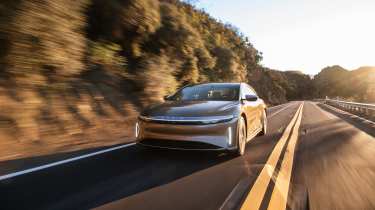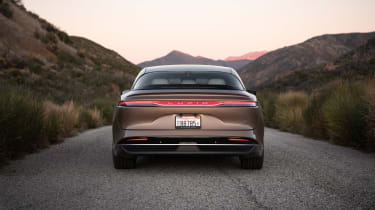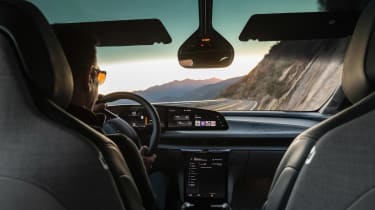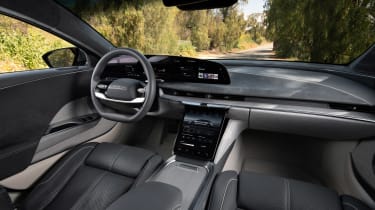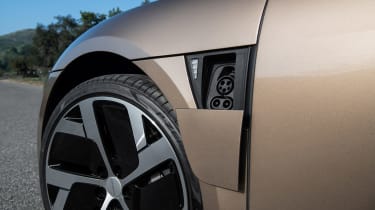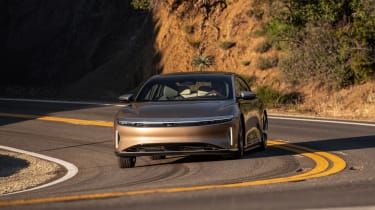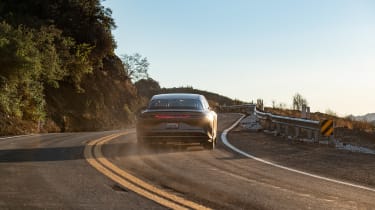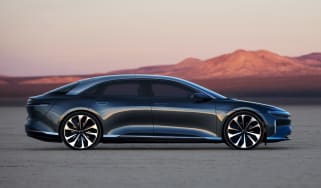Lucid Air Dream Edition 2022 review – a new-age EV to keep Tesla on its toes?
The Lucid Air combines genuine driver appeal with true innovation, this disruptive 1111bhp supersaloon might just revolutionise the EV class as the Tesla Model S did before it
This is the most highly anticipated electric car since the Tesla Model S – this is no understatement. It’s called the Lucid Air, a pure EV from a Silicon Valley start-up with huge ambitions, motorsport pedigree (they supply batteries to Formula E) and personnel who know what it means to truly turn the world upside down. CEO and CTO Peter Rawlinson formerly served as vice president of vehicle engineering at Tesla and was chief engineer on the Model S project, the clean-sheet design that established Tesla and set it on the path to becoming the most valuable car manufacturer on the planet.
In what must feel like a previous life, Rawlinson was also chief engineer at Lotus Cars and principle engineer at Jaguar. It’s quite the journey. Now, imagine if Lucid could create a car with as seismic a shift in technology as the Model S, coupled to the dynamic polish of a Lotus or the very best Jaguars. Surely the world as we know it would never be quite the same again? Well, here’s the very first attempt. No wonder the launch cars are called the Dream Edition.
This is the one that’s all about performance at the expense of range: the Dream Edition P, for ‘Performance’. In the official US-market EPA range calculation it only comes out with a score that’s 259 miles better than a Taycan Turbo S. Yes, this really is the one less concerned with range. The Porsche manages just 212 miles to the Dream P’s 471 miles. This alone is quite an incredible statistic but when combined with the Lucid’s power advantage it’s scarcely believable. This rather elegant-looking saloon is propelled by dual motors with a combined output of 1111bhp.
Just think about that for a moment. Lucid’s first model in its ultimate specification has more than twice the range of the Taycan Turbo S and an additional 495bhp at its disposal. It weighs 65kg more than the 2295kg Porsche but is physically slightly bigger and has vastly – and I mean vastly – more cabin space. It’s also around $15,000 cheaper at $170,500. If BMW or Mercedes launched a car with such a massive and tangible advantage over the Porsche we’d be utterly dumbstruck. It may not have Cup 2 tyres or plastic windows and it favours a low drag coefficient over downforce, but the Lucid Air is a car that we couldn’t ignore.
More reviews
So, we find ourselves in the strange town of Ojai, California, in the Los Padres National Forest, as the sun starts to burn off a freezing early morning chill and glint from the Eureka Gold bodywork of this intriguing new spaceship. Lucid’s HQ is in Newark, another five hours north of here near San Francisco, and its new factory is in Casa Grande, Arizona. The clogged streets of San Francisco would be a fitting place to drive the Air in some respects but that doesn’t sound like any fun at all. And a 1111bhp supersaloon should be fun.
Highway 33 is more like it. A stunning road of vast scale, it rises out of Ojai in a series of hairpins, fast sweeps and breathtaking, meandering straights along exposed ridgelines. It’s testing and much more unpredictable than many of California’s famed routes, but wide enough for something like a BMW M5 or Porsche Taycan Turbo S to really shine. A stage worthy of the next great Silicon Valley disruptor. Or just a great driver’s car.
Lucid is keen to point out that the Air is not intended to be a head-on rival for the Taycan Turbo S and is instead focused on the much more luxurious Mercedes-Benz S-class. However, with three distinct driving modes – Smooth, Swift and Sprint – there’s plenty of adaptability in this chassis. Intriguingly, for those sportier settings this brand new and deeply innovative EV manufacturer chose an unexpected benchmark – the E39 BMW M5. If nothing else this suggests that Lucid understands what makes enthusiasts tick. David Lickfold is Lucid’s director of chassis and vehicle dynamics and also formerly of JLR. More importantly he used to own a track-prepared E36 M3 inspired by my old Target 8-minutes project car. Small world, eh?
With outrageous performance stats (0‑60mph in 2.5sec, standing quarter-mile in under 10sec at over 140mph, a top speed of 168mph), disparate dynamic benchmarks and a kind of Citroën DS of the future remixed with 1950s US glamour aesthetic, I genuinely don’t know what to expect of this wholly new proposition. Other than nausea-inducing straight-line performance. I decide to ease myself in and start in the mild ‘Smooth’ mode. So configured, the Air takes aim at the S-class and has a mere 804bhp.
First thing’s first: when you drop into the beautifully architectural seats of the Air it feels fresh and different but still very much like a car. This might sound a strange observation but so keen are ‘legacy manufacturers’ to show how unreservedly they’re embracing this new form of mobility (barrfff) that they love to abandon basic principles. The Mercedes EQS and its Hyperscreen, where the entire dashboard structure is behind glass and houses vast touchscreens, is an absurdly over-complex and migraine-inducing case in point.
By comparison, Lucid has gone simple, clean and minimalist. The sweeping main display is substantial and has superb functionality, but it doesn’t fight for your attention with gimmicky tricks. It features 5K resolution, a tasteful colour palette and a logical interface – the screen to the left controls driving functions such as headlights, in the middle is a traditional instrument display and to the right you can control navigation, media and communication. The central, portrait-orientated ‘Pilot Panel’ allows access to a host of other functions including drive modes and climate control and can retract into the dash should you want an even calmer feel. Or a more focused feel too, I suppose. Another little sign that the people behind Lucid actually enjoy driving.
It’s so airy in here. Much of this is to do with the way the windscreen melds seamlessly into a full glass roof, creating an extraordinary sense of space and light and of modern, thoughtful luxury. So too the way the driver’s environment and rear passenger section are trimmed in different colours. Fresh thinking everywhere. However, there’s more to the Lucid’s interior space than a glass roof. I haven’t mentioned the structure and powertrain of the Air up to now because, well, EV architecture is mostly very similar and not particularly inspiring. As you’d expect, there’s a skateboard-style structure and, in the Dream Edition, a 112kWh battery pack featuring 6600 cells. It runs a 900V system for added efficiency (the higher the voltage, the lower the current, reducing heat loss created by electrical resistance) with huge benefits in terms of charging time, too.
Okay, this still isn’t very sexy stuff. The drive units – one for each axle – are pretty special, though. Consisting of electric motor, inverter and integrated transmission and differential, each unit weighs 74kg and produces up to 670bhp. Lucid claim this to be 45 per cent lighter and 59 per cent more powerful than any competitor’s equivalent. You could fit an entire drive unit into a standard airline carry-on roller suitcase. Although EasyJet might moan a bit about the weight. This remarkable ‘miniaturisation’, all of which is proprietary technology, has created the most power dense drive units on the market, coupled to the most efficient batteries. The motors spin at up to 20,000rpm. They also help create that superbly commodious interior space and huge additional front luggage compartment. A Taycan owner (or, more accurately, passenger) would feel like they’d just moved from a studio apartment to a penthouse suite.
The twin hollow-spoked steering wheel looks odd but intriguing (much like the entire car) and the rim feels a bit too chunky to me. Even so, I’m excited. It’s rare to drive something all new in every sense. Flick the right-hand stalk down to select D and then smoothly accelerate away. Lickfold has configured the car as a starting point but I can play with the strength of regen and whether I want it to creep like a traditional torque-converter auto. He also suggests I turn off the traction control immediately to experience the car’s natural balance. Maybe I’ll give it five minutes.
I’m still not a huge fan of one-pedal driving and so, to my shame, stick with the more conventional driving experience. This backs off the regen effect, which is reduced further still in Swift and Sprint modes to mimic the braking effect of an internal combustion engine and create a natural, intuitive experience. And when you brake you always get real braking from the Akebono six-piston calipers at the front and four-pots at the rear. There’s no regen/braking crossover point that so often feels artificial, jarring and inconsistent.
All is calm and quiet, just as you’d expect. The Air rides really nicely. It foregoes air springs for conventional coils in the name of efficiency, but does feature Bilstein Damptronic Sky dampers, which can also be found on the S-class. Some people have lamented the lack of air springs but for me it’s a good thing. I rarely find them capable of dealing with small surface ripples and they have a tendency to shuffle the car off line should you hit a rapidly corrugated section of road. The Air has no such issues and manages to feel lovely and fluid but with just enough sense of connection. Lickhold is still tweaking calibration here and there and arrived in a Porsche 992 GT3 he has in for benchmarking. It’s a broad church they’re drawing from. Sadly, the steering isn’t quite there yet and whilst the Air is responsive and accurate the steering itself has little in the way of actual feel.
What’s already clear is that Lucid has not created a Taycan Turbo S clone in any sense. Nor an S-class. Instead it sits somewhere between the two; on the one hand offering a new, simpler and almost boutique hotel luxury experience, and on the other trying to create a driver’s car that’s more about fluidity than the almost spookily flat, supremely alert Porsche. Judging it on its own merits is key but also slightly tricky. Usually a car with this level of performance has a Turbo, LT, CS or Pista badge applied. This? It’s a luxurious grand touring saloon car. Just try to remember that when you open up the taps.
Oh yes, even with ‘just’ 804bhp the Lucid feels unbelievably rapid and in that distinctive EV way. It hits instantly and very hard and then the acceleration doesn’t grow or change. Instead you’re just held by a constant, near-silent force, speed readout spinning improbable numbers and the world being sucked towards you in a fluid blur. Select Sprint for the full 1111bhp and the Air has surreal performance. It doesn’t set your hairs tingling like a 765LT or, more pertinently, an M5 CS, but there’s something fascinating about the way full throttle at 30mph or 80mph (or, I’m sure, 130mph) results in the same shocking intensity. It’s not a wave but rather a brick wall.
Swift and Sprint modes also unleash the Air’s full chassis potential, apportioning more torque to the rear axle, loosening the traction control and increasing the damping force to keep all that weight under tighter control. It works, too. As I said, the Air can’t hope to match the on-limit sharpness that so characterises the Porsche Taycan, and without rear-wheel steering it’s nothing like as agile. Yet there’s enjoyment to be had here. The balance is just as you’d hope. Barrel in clumsily and you’ll get understeer. However, if you’re reading the road correctly and nail the entry speed, every bit of additional throttle starts to steer the car from the rear. If you’re of a mind you can exit most turns with a little hint of oversteer, and although there’s a fair amount of body roll the Lucid retains its sense of balance and cohesion even over the limit.
Now, the limit itself is worth talking about. You see, the Lucid is painstakingly, meticulously, obsessively concerned with efficiency right to the very core of its being. Getting that huge range was everything for this car, to truly showcase how it moves the game on. There’s also a Dream Edition R, for ‘Range’, with a maximum of 933bhp and an EPA rating of 520 miles. The very first EV ever to achieve a certified 500-miles-plus rating. This was the real story… the power is almost incidental.
Anyway, for range you need very little drag (the Air has a Cd of 0.21 on 19-inch wheels) and low rolling resistance tyres. Our test car is wearing the optional 21-inch wheels and new Pirelli P Zero HL (high load) tyres that are specifically designed for EV applications. The sizes are very modest – 245/35 fronts and 265/35 at the rear. That’s 30mm narrower at the front and 20mm narrower at the rear than the tyres fitted to the 626bhp M5 CS. And the BMW wears extreme P Zero Corsas. So, the Lucid has nearly 500bhp more to put to the road, a much smaller footprint and tyres focused on efficiency rather than grip. You can probably guess where this is going…
Quite simply the Lucid doesn’t have anything like the outright grip of other cars of similar performance and, of course, that impacts everything. The brakes have a slightly long pedal yet they’re strong and resist fade well. However, they only have that small contact patch to work with and so stopping distances can’t compete with those of, say, the M5 CS. So, you arrive faster at a corner than you might in the BMW but don’t have the braking response, the lateral grip, nor the traction on corner exit.
This requires a rapid and fundamental readjustment if you want to really drive the Air hard. It seems strange to say but you have to treat this wildly powerful and in many ways futuristic car a bit like a classic. Setting it up early for corners, loading the chassis progressively and then using the neutral handling balance to four-wheel drift out of turns. This is rewarding and enjoyable, no question. Just unexpected. We’ve grown so used to endless front-end grip that driving a car that requires this level of management – particularly one with such outrageous power – is a different taste. For me a narrow footprint like this but with a more aggressive tyre would perhaps be the sweet spot. As it is I think the performance/grip balance is swung too far in favour of raw power. I’d happily give up some range to create more agility and response and gain better access to a chassis that’s clearly very sweetly sorted when worked hard.
It’s not lost on me that many Lucid Airs will live in cities, zapping quietly between traffic lights and junctions and feeling very at home indeed. Nor that an S-class might possess more grip but would also feel a little out of its comfort zone on a road that climbs, heaves and coils up the side of a mountain. In fact, it’s a testament to the basic rightness of the Air’s chassis calibration that I can’t help but crave a bit more grip, response and maybe another setting beyond Sprint. I don’t know… maybe Track would do it.
Prices and rivals
The Lucid Air Dream Edition P is a remarkable car, even more so when you consider it’s from a brand new company. No wonder Lucid has already received more than 25,000 orders and has plans to produce up to 400,000 cars per annum. Next up is, inevitably, an SUV called Gravity. And don’t think the Air is an expensive, 1111bhp irrelevance. There’s a single-motor, rear-drive Pure variant with 480bhp and a range of 406 miles available from $77,400, plus 620bhp Touring and 800bhp Grand Touring dual-motor models.
This puts in the game with Merc's EQS in the USA, while sitting above an equivalent Porsche Taycan, Audi e-tron GT and the Tesla Model S. None has quite the content, and only the Tesla Plaid gets close to its straight-line performance.
If big numbers really are your thing, Lucid has you covered, too. A tri-motor version is already in the works. It will be more extreme, more focused, have greater torque-vectoring capabilities with a motor for each rear wheel and will probably produce around 1500bhp. More exciting to me is that the ‘miniaturisation’ of the drive units and the ultra-efficient batteries suggest a relatively lightweight, single-motor sports car isn’t beyond the realms of possibility. Lucid might not offer the dynamic capabilities of an equivalent Porsche just yet, but the technology it is already producing is miles ahead and could provide us with some very exciting cars in the future.

